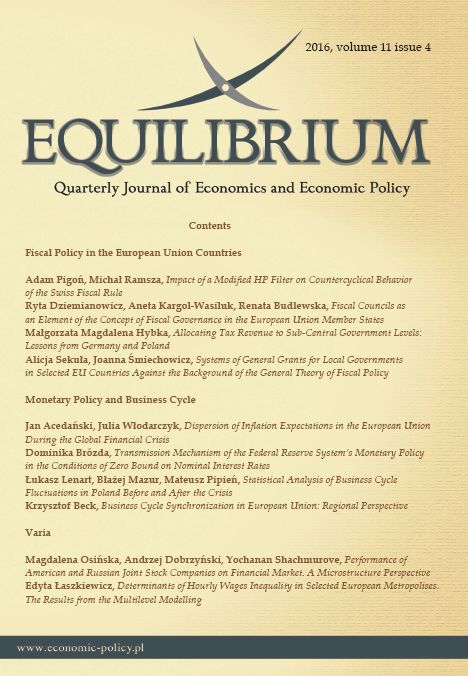BUSINESS CYCLE SYNCHRONIZATION IN EUROPEAN UNION: REGIONAL PERSPECTIVE
BUSINESS CYCLE SYNCHRONIZATION IN EUROPEAN UNION: REGIONAL PERSPECTIVE
Author(s): Krzysztof BeckSubject(s): Economy, National Economy, Supranational / Global Economy
Published by: Instytut Badań Gospodarczych
Keywords: business cycle synchronization; regional economics; optimum currency area theory; Hodrick-Prescott filter; European integration
Summary/Abstract: The recent turmoil in the euro area once more forces the EU authorities to reconsider the future of further monetary integration. One of the most commonly used criteria for successful monetary integration in contemporary research is business cycle synchronization (BCS). Though BCS has been vastly described at country level, not as much attention has been paid to the degree of BSC at regional level. The topic is important for two main reasons. Firstly, determining the degree of BCS at the regional level can help in the assessment of monetary policy effectiveness on the country level, as well as give a point of reference for evaluation of prospective costs of participation in a monetary union. Secondly, there is a theoretical dispute within the optimum currency areas literature between the ‘European Commission’ and the ‘Krugman’ view that can be resolved to a large extent trough regional analysis. In order to assess BCS in the EU, Hodrick-Prescott, as well as Christiano and Fitzgerald filter to time series of real GDP for 24 countries, 82 NUTS 1, 242 NUTS 2 and 1264 NUTS 3 regions over the period between 1998 and 2010. The data was later used to create bilateral measures of BSC, which gave 276 observations on the country level, 3321 on NUTS 1, 29161 on NUTS 2 and 798216 on NUTS 3 level. The results of the analysis support the ‘European Commission’ view and show a very high degree of BSC within EU countries. The country level analysis also reveals that within the EU there is a group of countries that could form an effectively working monetary union based on the BCS criterion.
Journal: Equilibrium. Quarterly Journal of Economics and Economic Policy
- Issue Year: 11/2016
- Issue No: 4
- Page Range: 785-815
- Page Count: 31
- Language: English

